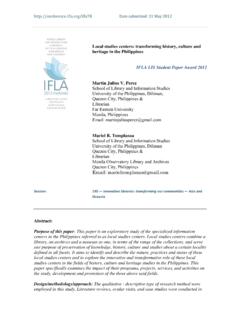Transcription of Pharmaceutical Compoundingand Dispensing, Second Edition
1 Pharmaceutical Compoundingand DispensingPharmaceuticalCompoundingand DispensingJohn F MarriottBSc,PhD,MRPharmS,FHEAP rofessor of Clinical PharmacyAston University School of Pharmacy, UKKeith A WilsonBSc,PhD,FRPharmSHead of SchoolAston University School of Pharmacy, UKChristopher A LangleyBSc,PhD,MRPharmS,MRSC,FHEAS enior Lecturer in Pharmacy PracticeAston University School of Pharmacy, UKDawn BelcherBPharm,MRPharmS,FHEAT eaching Fellow, Pharmacy PracticeAston University School of Pharmacy, UKSECOND EDITIONP ublished by the Pharmaceutical Press1 Lambeth High Street, London SE1 7JN, UK1559 St Paul Avenue, Gurnee, IL 60031, USA Pharmaceutical Press 2010is a trade mark of Pharmaceutical PressPharmaceutical Press is the publishing division of the Royal Pharmaceutical Society ofGreat BritainFirst Edition published 2006 Second Edition published 2010 Typeset by Thomson Digital, Noida, IndiaPrinted in Great Britain by TJ International, Padstow, CornwallISBN 978 0 85369 912 5 All rights reserved.
2 No part of this publication may be reproduced, stored in a retrievalsystem, or transmitted in any form or by any means, without the prior writtenpermission of the copyright publisher makes no representation, express or implied, with regard to theaccuracy of the information contained in this book and cannot accept any legalresponsibility or liability for any errors or omissions that may be right of John F Marriott, Keith A Wilson, Christopher A Langley and Dawn Belcherto be identified as the author of this work has been asserted by them in accordance withthe Copyright, Designs and Patents Act.
3 Catalogue record for this book is available from the British the authorsxAcknowledgementsxiMuseum of the Royal Pharmaceutical SocietyxiiBritish Society for the History of PharmacyxivOnline materialxvPart 1 History of compounding11 Historical perspective3 The origins of the pharmacy profession3 Foundation of the Royal Pharmaceutical Society of Great Britain5 Pharmacy legislation6 Development of the pharmacopoeias82 Obsolete dosage forms, equipment and methods of preparation17 Obsolete Pharmaceutical preparations and preparative methods18 Old Pharmaceutical equipment34 Old Pharmaceutical containers383 Historical weights and measures41 Metrication41 Part 2 Pharmaceutical forms and their preparation474 Key formulation skills49 Weights and measures49 Medication strength595 Extemporaneous dispensing65 Guide to general good practice requirements65 Suitable record keeping67 Equipment67 Product formulae74 Ingredients75 Storage and
4 Labelling requirements91 Pharmaceutical packaging966 Solutions101 Introduction and overview101 General principles of solution preparation103 Oral solutions104 Gargles and mouthwashes105 Enemas and douches105 External solutions105 Worked examples106 Summary of essential principles relating to solutions1127 Suspensions115 Introduction and overview115 General principles of suspension preparation116 Oral diffusible suspensions117 Oral indiffusible suspensions119 Suspensions for external use119 Worked examples120 Summary of essential principles relating to suspensions1278 Emulsions131 Introduction and overview131 Formulation of emulsions133 General method of preparation of an emulsion using the dry gum method135 Stability of emulsions136 Emulsions for external use137 Worked examples138 Summary of essential principles relating to emulsions1519 Creams153 Introduction and overview153 Terminology used in the preparation of creams, ointments.
5 Pastes and gels153 General principles of cream preparation154 Worked examples156 Summary of essential principles relating to creams16010 Ointments, pastes and gels163 Introduction and overview163 Ointments163 Pastes165 Gels167 Worked examples170 Summary of essential principles relating to ointments, pastes and gels18111 Suppositories and pessaries183 Introduction and overview183 General principles of suppository and pessary preparation184 General method for suppository preparation186 Worked examples187 Summary of essential principles relating to suppositories and pessaries192vi|Contents12 Powders and capsules195 Introduction and overview195 Bulk powders for external use195 Bulk oral powders196 Individual unit dose powders197 Unit dose capsules199 Worked examples202 Summary of essential principles
6 Relating to powders and capsules20513 Specialised formulation issues207 Introduction and overview207 Posology207 Dermatological extemporaneous formulation213 Further reading215 Part 3 Product formulae217 Preface21914 Creams22515 Dusting powders22916 Internal mixtures23117 Liniments, lotions and applications24918 Ointments and pastes25319 Powders25720 Miscellaneous formulae259 Appendix 1 Glossary of terms used in formulations261 Appendix 2 Abbreviations commonly used in pharmacy263 Appendix 3 Changing substance names from British Approved Namesto recommended International Non-Proprietary Names265 Bibliography271 Index273 Contents|viiPrefacePharmacists or their Pharmaceutical equivalents havebeen responsible for compounding medicines for cen-turies.
7 Recently this role has been challenged in thepharmaceutical literature with suggestions and recom-mendations that it is inappropriate for the pharmaceu-tical practitioner to compound medicines in a localpharmacy environment . Notwithstanding this validdebate, it is clear that a vast array of skills and knowl-edge with regard to medicines compounding has beenaccrued and refined, certainly over the last two centu-ries. In the present environment it is possible that thisknowledge and skill base might be dispersed and ulti-mately lost.
8 However, it is not beyond the bounds ofimagination to conceive that there will be times, albeitpossibly in the face of some form of environmental,cultural or local emergency, when pharmacists mightbe called upon to extemporaneously compound med-icines when conventional supply chains are eitherunavailable or have broken text has been designed with a number of func-tions in mind. First, it is important to be aware of someof the historical pathways that have led to the presenttechnological position of pharmacists.
9 In addition,unless many of the antiquated measuring systems,methodologies and formulations are preserved insome reference work, they might be lost forever, orat least be totally unavailable except to the doggedhistorian. Primarily, however, this work is intendedas a reference-based tutorial to the methods employedin medicines compounding. The text has been designedto allow students and practitioners to be able to exam-ine either all or part of the subsequent chapters in orderto familiarise themselves with the compounding tech-niques necessary to produce products of appropriatequality and efficacy.
10 In addition, the text is supportedby moving images in order to augment the necessarytechniques and text also has a role when considering thedesign and implementation of standard operating pro-cedures (SOPs) pertinent to certain sectors of profes-sional practice today. Although we do not expect allpractitioners of pharmacy to be compounding medi-cines on a daily basis, we hope that should the needarise this text will effectively support any work of thisnature that might be Second Edition has updated the first editionand, to assist the student compounder, the text nowincludes examples of the Pharmaceutical label for eachworked F MarriottKeith A WilsonChristopher A LangleyDawn BelcherBirmingham.





